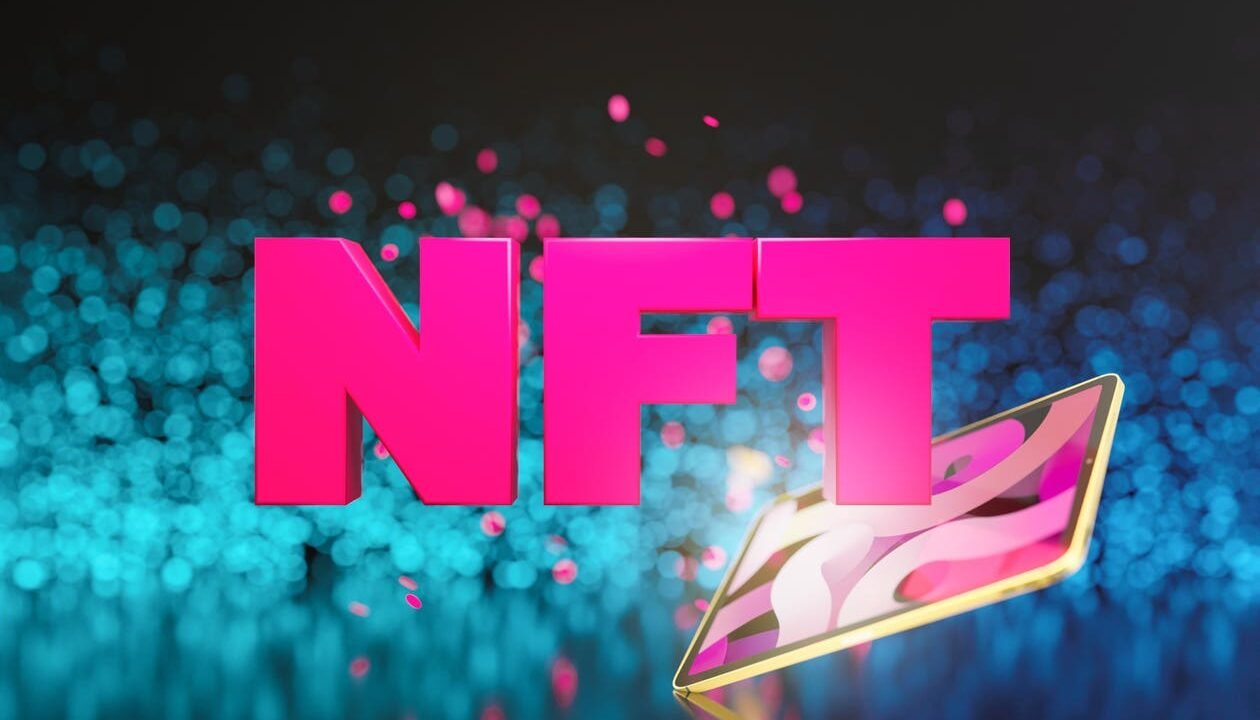
Image of the text NFT.
Non-fungible tokens and decentralized applications are changing how we own and trade digital assets. NFT dApps combine these technologies, creating platforms for digital art, gaming and more. This article explores NFT dApps and their impact on various industries.
NFT dApps have become a cornerstone of the Web3 ecosystem, driving significant transaction volumes. These platforms are reshaping creator economies by enabling direct-to-fan sales and automated royalties. For investors, NFT dApps offer exposure to an emerging asset class with potential for high-value transactions.
What Are NFTs?
NFTs are digital tokens that represent ownership of unique items or content on a blockchain. Unlike cryptocurrencies, each NFT has a distinct value and cannot be exchanged on a one-to-one basis. They provide verifiable proof of ownership for digital assets.
NFTs have transformed how digital content is valued and traded. Creators can now sell their work directly to buyers, eliminating traditional middlemen. This shift has opened new revenue streams for artists and given collectors assurance of authenticity. NFTs can represent various digital assets, including art, music, virtual real estate and in-game items.
NFT Characteristics
NFTs are cryptographic tokens with unique identifiers stored on a blockchain. Each token has distinct metadata and asset information, making it non-fungible. For example, an NFT representing digital art includes data like the artist’s wallet address, creation date, and a link to the artwork file.
Blockchain records every NFT transaction, creating a verifiable ownership trail. This data is public and immutable. Users can trace an NFT’s history from its creation through all transfers using block explorers. Smart contracts automate NFT functions like minting, transferring ownership and executing royalty payments to creators on secondary sales.
Popular NFT Examples
Digital art NFTs entered the mainstream spotlight with Beeple’s $69 million “Everydays” sale at Christie’s in 2021. CryptoPunks, 10,000 unique pixel art characters, have traded for millions. Bored Ape Yacht Club NFTs serve as both digital art and access passes to exclusive events and merchandise. In sports, NBA Top Shot offers licensed video clip collectibles of memorable plays.
Gaming NFTs include Axie Infinity’s breedable creatures and Decentraland’s virtual land parcels. Music NFTs from Kings of Leon and Grimes offer exclusive content and experiences. Virtual fashion NFTs by Gucci have sold in online environments. Twitter’s founder sold his first tweet as an NFT for $2.9 million.
What Are dApps?
dApps are software programs that run on blockchain networks rather than centralized servers. They operate on peer-to-peer networks, eliminating the need for intermediaries. dApps leverage smart contracts to automate processes and ensure transparent, trustless interactions.
dApps increase security through blockchain’s immutable nature. They also enhance privacy as users maintain control of their data. Finally, dApps improve transparency because all transactions are recorded on a public ledger.
Key Features of dApps
dApps operate on blockchain networks, using smart contracts to automate processes without central authorities. Their open-source code allows public review and encourages community contributions. dApps use native tokens or cryptocurrencies for in-app transactions and governance. Consensus mechanisms like Proof of Stake or Proof of Work validate transactions and maintain network integrity. These applications store immutable transaction records on the blockchain, boosting transparency and security.
Many dApps integrate with Web3 wallets for user authentication and transactions. They often utilize decentralized storage solutions to store and retrieve data. Tokenomics models incentivize user participation and network growth in many dApps. Interoperability protocols allow dApps to connect across blockchains, expanding their utility.
Popular dApp Examples
Uniswap
Uniswap
Aave
Compound
OpenSea hosts an NFT marketplace. Chainlink
Chainlink
Dai
What Are NFT dApps?
NFT dApps help users to create, buy, sell and trade unique digital assets without intermediaries. These platforms combine NFT scarcity and authenticity with dApp decentralization for peer-to-peer transactions.
Smart contracts in NFT dApps automate minting, ownership transfers and royalty management. This creates new digital ownership models across industries. Artists sell directly to collectors, gamers trade in-game items, and users buy virtual real estate in metaverses. NFT dApps are reshaping markets in art, gaming and entertainment, while opening new investment opportunities in the digital space.
Types of NFT dApps
NFT dApps can be categorized based on their primary functions and the industries they cater to. The main types include marketplace dApps, gaming dApps, art and collectible dApps, and social and metaverse dApps. Each type offers unique features and benefits to users in the NFT ecosystem.
Marketplace dApps
NFT marketplace dApps let users mint, buy, sell and trade NFTs on blockchain networks. These platforms use smart contracts to automate listings, auctions and instant sales without intermediaries. They verify ownership, manage royalties and provide secure storage for digital assets.
In the blockchain ecosystem, NFT marketplaces create liquidity for digital assets. They connect creators directly with collectors, creating new economic models for digital content. These dApps support standards like ERC-721 and ERC-1155 on Ethereum
Ethereum
OpenSea leads the NFT marketplace space with $37.33 billion in trading volume. Blur
Blur
Gaming dApps
Gaming dApps integrate NFTs as in-game assets, allowing players to truly own and trade their virtual items. This model, often called “play-to-earn,” enables gamers to monetize their time and skills within the game ecosystem. NFTs in gaming can represent characters, weapons, land or other tradable assets.
The Sandbox offers a virtual world for building and monetizing experiences. Alien Worlds features NFT-based mining and combat. Gods Unchained gives players ownership of digital trading cards. Sorare focuses on fantasy football with NFT player cards.
Art And Collectible dApps
Art and collectible dApps focus on creating, showcasing and trading digital art and unique collectibles as NFTs. These platforms provide artists with new ways to monetize their work and offer collectors verifiable ownership of digital assets. They often include features like provenance tracking and royalty distribution.
Foundation operates as a decentralized platform for artists to mint and auction digital artworks. SuperRare runs on Ethereum, allowing artists to tokenize and sell single-edition artworks. Rarible enables community-governed creation and trading of NFTs.
Social And Metaverse dApps
Social and metaverse dApps use NFTs to represent digital identity, social status or ownership within virtual worlds. These platforms aim to create immersive digital experiences where users can interact, socialize and engage in various activities using NFT-based assets.
The Sandbox has sold virtual land parcels, allowing users to create and monetize experiences. Decentraland hosts virtual events and allows users to buy and develop digital real estate. Somnium Space offers a VR-compatible metaverse where users own and trade virtual properties. Cryptovoxels provides a blockchain-based world where users can build and showcase art galleries or stores.
How NFT dApps Work
When a user wants to create an NFT, they interact with the dApp’s interface to upload their digital asset and set its properties. The dApp then communicates with a smart contract on the blockchain, which mints the NFT by generating a unique token ID and linking it to the asset’s data.
For selling or buying NFTs, users browse the dApp’s marketplace and initiate transactions through the interface. The dApp relays these commands to smart contracts, which handle the transfer of ownership and any associated cryptocurrency payments. Throughout this process, the blockchain records all transactions, ensuring a transparent and secure history of ownership for each NFT.
Underlying Technology
NFT dApps are built on blockchain platforms that support smart contracts, with Ethereum being the most widely used. These platforms provide the infrastructure for creating and managing unique digital assets. The blockchain’s distributed ledger records every NFT transaction, maintaining a transparent and unchangeable ownership history.
Many NFT dApps use decentralized storage solutions like InterPlanetary File System to store NFT-associated content. This approach enhances digital asset longevity and accessibility by reducing dependence on centralized servers. The combination of blockchain for transaction processing and decentralized storage for content creates a strong system for NFT management and trading.
Smart Contracts And NFTs
Smart contracts are self-executing programs on the blockchain that automate NFT processes. For NFTs, these contracts define token properties, including uniqueness, ownership rights and metadata. When a user mints an NFT, the smart contract generates a unique token ID and links it to the specified digital content.
In NFT transactions, smart contracts handle ownership transfers and payments. They can also implement royalty systems, automatically allocating a percentage of secondary sales to the original creator. This automation ensures that NFT sales and transfers execute exactly as programmed, without intermediaries.
User Experience And Interactions With NFT dApps
NFT dApp interfaces typically feature galleries for browsing assets, tools for minting NFTs, and marketplaces for buying and selling. Users interact with these features through web or mobile applications. To use an NFT dApp, users must connect a blockchain wallet like MetaMask, which stores their digital assets and signs transactions.
The dApp communicates with the user’s wallet to authorize actions on the blockchain. When a user mints, buys or sells an NFT, the interface prompts them to approve the transaction through their wallet. This process ensures secure interaction with the blockchain while maintaining a user-friendly experience. Some dApps also offer additional features like bidding systems, royalty management and collection tools.
Benefits Of NFT dApps
NFT dApps provide a way to create, buy, sell and own unique digital items without centralized authorities. These applications enable direct creator-to-consumer sales, automate royalty payments and offer verifiable scarcity for digital goods. NFT dApps are reshaping how we value and interact with digital content across industries, from art and collectibles to gaming and virtual real estate.
Decentralization And Security
NFT dApps distribute data across a network of nodes, eliminating points of failure. This decentralization makes system compromise difficult. Blockchain’s cryptographic techniques ensure transaction immutability, preventing alterations or deletions of NFT ownership records. Public verification of transactions on the blockchain enhances trust and transparency.
Ownership And Authenticity Verification
Each NFT has a unique blockchain identifier, creating an unambiguous ownership record. Users can trace an NFT’s provenance from creation through all ownership transfers. This feature prevents fraud and adds value by providing verifiable history. It’s particularly useful in industries prone to counterfeiting, such as art and collectibles.
Monetization Opportunities For Creators
Creators can tokenize and sell their work directly to audiences without intermediaries, often resulting in higher profits. Many NFT dApps implement automatic royalty systems, allocating a percentage of secondary sales to the original creator. This feature enables ongoing revenue from appreciating work. Smart contracts ensure fair compensation by programming these royalties into the NFT itself.
Interoperability And Asset Portability
NFT standards like ERC-721 and ERC-1155 enable asset interoperability across different platforms. Users can transfer NFTs between compatible dApps, increasing utility and liquidity. This feature allows for cross-platform gameplay in gaming dApps and multi-marketplace trading for art NFTs, expanding the ecosystem for digital assets.
Programmable Functionality
Smart contracts enable programmable NFTs with dynamic properties and behaviors. These can include evolving artwork, interactive game items or NFTs that respond to external data feeds. Programmability allows for complex royalty structures, time-based features and conditional transfers, enhancing NFT utility and value propositions.
Fractional Ownership And Increased Accessibility
Some NFT dApps support fractional ownership, allowing multiple users to own shares of high-value NFTs. This feature democratizes access to expensive digital assets. Fractional ownership also increases liquidity for high-value NFTs and allows for new investment strategies in digital collectibles.
Challenges And Risks
As with any emerging technology, NFT dApps face a range of challenges and risks. These issues require time to resolve or find an appropriate balance. The NFT ecosystem is facing technical limitations, security vulnerabilities, market instabilities and legal uncertainties. Developers, users and regulators are working to address these challenges and establish best practices.
Scalability Issues
Ethereum, hosting most NFT dApps, processes a limited number of transactions per second. During peak times, high gas fees make small transactions impractical. Layer-2 solutions like Polygon
Polygon
Alternative chains like Solana
Solana
Security Concerns
Smart contract exploits have resulted in significant losses. The Ronin Network hack in March 2022 led to a $620 million theft. In 2021, the Poly Network breach saw over $600 million stolen, though later returned.
Phishing attacks are common. In 2022, OpenSea users lost $1.7 million in a single attack. NFT wash trading for artificial price inflation accounted for $35.4 billion wash trading volume in 2022.
Market Volatility
The NFT trading volume peaked at $23 billion in December 2021, then dropped to $3.7 billion by October 2022. Individual NFT prices show extreme volatility. Bored Ape Yacht Club NFTs saw their floor price drop from 152 ETH in April 2022 to 13 ETH in August 2024.
BAYC floor price plunged 91% from 152 ETH to 13 ETH since April 2022.
Monthly trading volume on OpenSea dropped from $641 million in February 2023 to $32 million in August 2024. This volatility affects creator income and investor returns, with many NFTs losing significant value post-minting.
Regulatory Uncertainty
NFTs operate in a legal gray area. Different jurisdictions classify NFTs differently, leading to inconsistent treatment. The U.S. SEC has not provided clear guidance on whether NFTs are securities, creating uncertainty for issuers and platforms.
In 2022, the first NFT insider trading case was brought against a former OpenSea employee, highlighting the need for clearer regulations and enforcement in the NFT space.
Copyright And Intellectual Property Issues
NFT minting of copyrighted material without permission is widespread. In 2022, DeviantArt detected over 245,000 instances of NFT art theft on its platform alone. This creates legal risks for both creators and buyers of unauthorized NFTs.
The relationship between NFT ownership and copyright remains unclear. Purchasing an NFT typically doesn’t transfer copyright of the underlying work, leading to potential disputes over usage rights.
The Future Of NFT dApps
The future of NFT dApps is likely to see increased integration with real-world assets and industries. We can expect a shift towards more utility-focused NFTs, moving beyond digital art to represent real estate, intellectual property rights and identity verification.
Improvements in blockchain scalability and interoperability will likely enhance NFT dApp functionality. Ethereum’s transition to proof-of-stake and the development of layer-2 solutions promise to reduce transaction costs and increase throughput. Cross-chain NFT platforms may enable seamless NFT transfers across different blockchains, expanding market liquidity and user options.
The metaverse concept is expected to drive significant growth in NFT dApps. Major tech companies like Meta and Microsoft are investing heavily in virtual worlds where NFTs could represent digital land, avatars and in-world items. Gaming industry leaders such as Ubisoft and Square Enix have also announced plans to incorporate NFTs, potentially bringing blockchain-based digital ownership to mainstream gaming audiences.
Bottom Line
NFT dApps are changing how digital assets are created, owned and traded. These applications enable direct creator-to-consumer sales, automate royalty payments and provide verifiable scarcity for digital goods. They’re reshaping industries from art and gaming to real estate and identity verification.
Challenges remain, including technical limitations, market volatility and legal uncertainties. However, as solutions emerge and adoption grows, NFT dApps are likely to become an integral part of the digital asset ecosystem, offering new ways to monetize creativity and redefine digital ownership.











